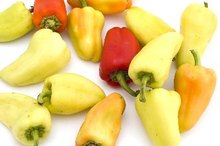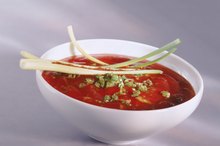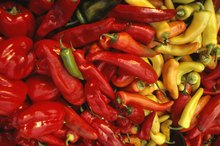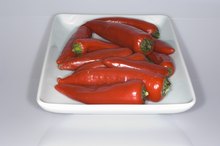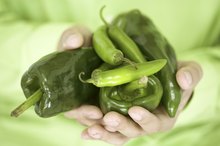What Are the Dangers of Eating a Habanero Pepper?
The habanero pepper is the one of the hottest peppers grown and consumed commercially. Habanero pepper sauces, salsas and dishes are popular in throughout the Caribbean, Mexico and Central America, but such fare is often too hot for people with milder palates. In most cases, eating raw habanero peppers poses no long-term health dangers, but even a single pepper can have an intense and fiery effect on your tongue and bowels.
If you are experiencing serious medical symptoms, seek emergency treatment immediately.
Capsaicin Brings the Heat
Habaneros and other chili peppers get their heat from capsaicin, an oil found in the seeds and inner ribs on the peppers. Capsaicin triggers the same nerves that tell the brain that it is getting too hot and causes a burning sensation. Scoville units measure the amount of capscaicin and, therefore, the amount of heat in a pepper or chili dish. According to the chili resource website Chili World, habanero peppers typically have 100,000 to 350,000 Scoville units of heat 1. In comparison, a cayenne pepper has 30,000 to 50,000 Scoville units of heat, and most popular hot sauces come in at 1,000 to 5,000 Scoville units.
Capsaicin is a potent oil, but there is no medical evidence that it is dangerous in any amount. The rumor that hot peppers cause ulcers is a myth, and capsaicin actually helps prevent ulcers by helping the stomach build up bile and killing unwanted bacteria. Capsaicin can aggravate preexisting ulcers and digestive disorders, so those suffering from any kind of digestive difficulty should consult their doctor before eating habaneros.
Your brain also responds to the burning sensation caused by capsaicin by releasing endorphins and other pain-relieving chemicals, and many chili enthusiasts report that they are addicted to the "high" they get from eating hot peppers.
- Habaneros and other chili peppers get their heat from capsaicin, an oil found in the seeds and inner ribs on the peppers.
- Your brain also responds to the burning sensation caused by capsaicin by releasing endorphins and other pain-relieving chemicals, and many chili enthusiasts report that they are addicted to the "high" they get from eating hot peppers.
Proceed with Caution
Do Red Bell Peppers Burn Fat?
Learn More
Habaneros have a high level of capsaicin, and the effects of eating a habanero can be extremely painful and euphoric for the uninitiated. The sensation of extreme heat can stay on the tongue for 20 minutes or more. The stomach and intestines can also feel that sensation, and in some cases, stomachaches and digestive discomfort follow.
A high dose of capsaicin can temporarily raise blood pressure and body temperature, so people with high blood pressure or a history of heart attacks should be careful when eating or cooking habaneros.
Capsaicin is an oil that sticks to fingers and can cause serious pain if it makes contact with the eyes or areas of sensitive skin. People who handle habaneros should wash their hands with soap and water before touch any part of their body.
- Habaneros have a high level of capsaicin, and the effects of eating a habanero can be extremely painful and euphoric for the uninitiated.
Hot and Healthy
Habaneros are both hot and healthy. Hot peppers of all sorts are high in minerals and Vitamins C and A. Capsaicin kills unwanted bacteria and intestinal parasites, and some people use hot peppers and powders to "flush" their bowels and cleanse their digestive track.
It is possible to build a tolerance to capsaicin, so the best way to enjoy heat and health benefits of habaneros and other healthy foods is to slowly increase the amount of spicy food included in a diet. While not necessarily dangerous, habaneros do pack quite a punch, and culinary adventurers interested in the chili can enjoy it best once they learn to handle the heat.
- Habaneros are both hot and healthy.
- While not necessarily dangerous, habaneros do pack quite a punch, and culinary adventurers interested in the chili can enjoy it best once they learn to handle the heat.
Related Articles
References
- Chili World: Chili Resources
- Nutrition Data.: Peppers, Hot Chili, Green, Raw
- Varghese S, Kubatka P, Rodrigo L, et al. Chili pepper as a body weight-loss food. Int J Food Sci Nutr. 2017;68(4):392-401. doi:10.1080/09637486.2016.1258044
- Sharma SK, Vij AS, Sharma M. Mechanisms and clinical uses of capsaicin. Eur J Pharmacol. 2013;720(1-3):55-62. doi:10.1016/j.ejphar.2013.10.053
- Whiting S, Derbyshire EJ, Tiwari B. Could capsaicinoids help to support weight management? A systematic review and meta-analysis of energy intake data. Appetite. 2014;73(1):183-8. doi:10.1016/j.appet.2013.11.005
- Whiting, S, Derbyshire, E, Tiwari, BK. Capsaicinoids and capsinoids. A potential role for weight management? A systematic review of the evidence. Appetite. 2012;59(2):341-348. doi:10.1016/j.appet.2012.05.015
- van Avesaat M, Troost FJ, Westerterp-Plantenga MS, et al. Capsaicin-induced satiety is associated with gastrointestinal distress but not with the release of satiety hormones. Am J Clin Nutr. 2016 Feb;103(2):305-13. doi:10.3945/ajcn.115.123414
- Zsiborás C, Mátics R, Hegyi P, et al. Capsaicin and capsiate could be appropriate agents for treatment of obesity: A meta-analysis of human studies. Crit Rev Food Sci Nutr. 2016 Dec 21:1-9. doi:10.1080/10408398.2016.1262324
- Urbina SL, Roberts MD, Kephart WC, et al. Effects of twelve weeks of capsaicinoid supplementation on body composition, appetite and self-reported caloric intake in overweight individuals. Appetite. 2017 Jun 1;113:264-273. doi:10.1016/j.appet.2017.02.025
- Pabalan N, Jarjanazi H, Ozcelik H. The impact of capsaicin intake on risk of developing gastric cancers: a meta-analysis. J Gastrointest Cancer. 2014;45(3):334-41. doi:10.1007/s12029-014-9610-2
- Heck, AM, DeWitt, BA, Lukes, AL. Potential interactions between alternative therapies and warfarin. Am J Health-Sys Pharmacy. 2000;57(13):1221-1227. doi:10.1093/ajhp/57.13.1221
- Sayin MR, Karabag T, Dogan SM, Akpinar I, Aydin M. A case of acute myocardial infarction due to the use of cayenne pepper pills. Wien Klin Wochenschr. 2012;124(7-8):285-7. doi:10.1007/s00508-012-0163-8
Writer Bio
Mike Ludwig is a freelance writer and journalist in the United States. He has worked as a freelance newspaper reporter, section editor and magazine feature writer. Ludwig has three years of freelance writing experience, and has been published in "Southeast Ohio Magazine," InTheFray.com and the alternative bi-weekly paper "The Athens NEWS."


